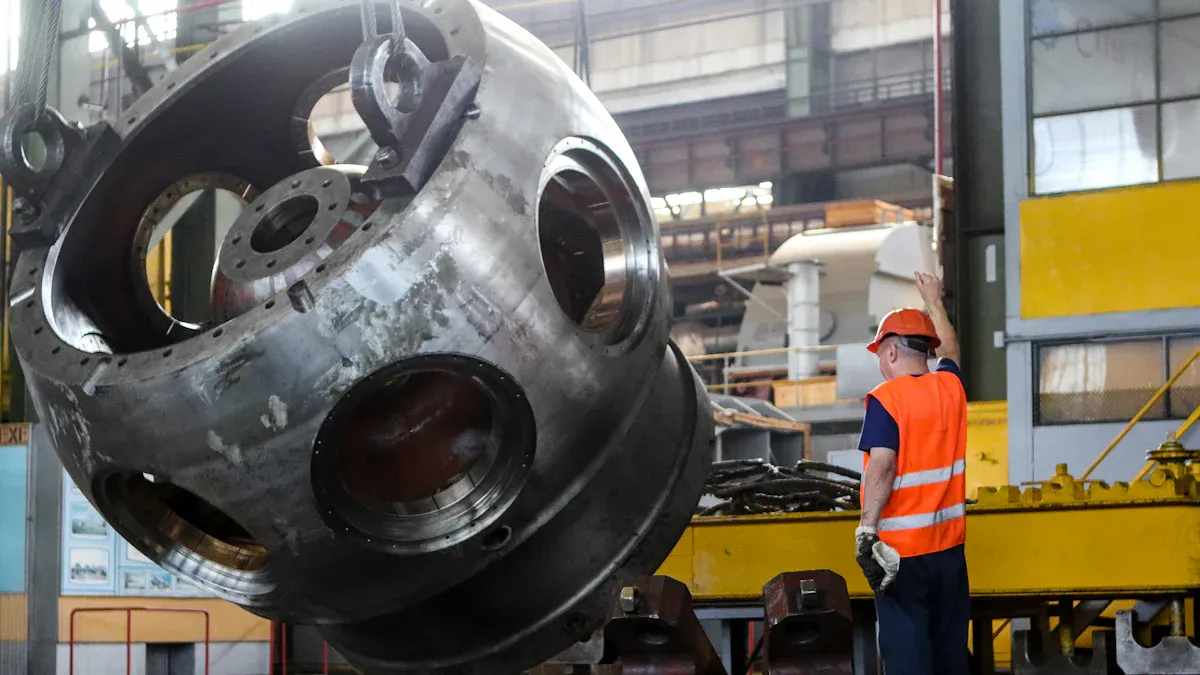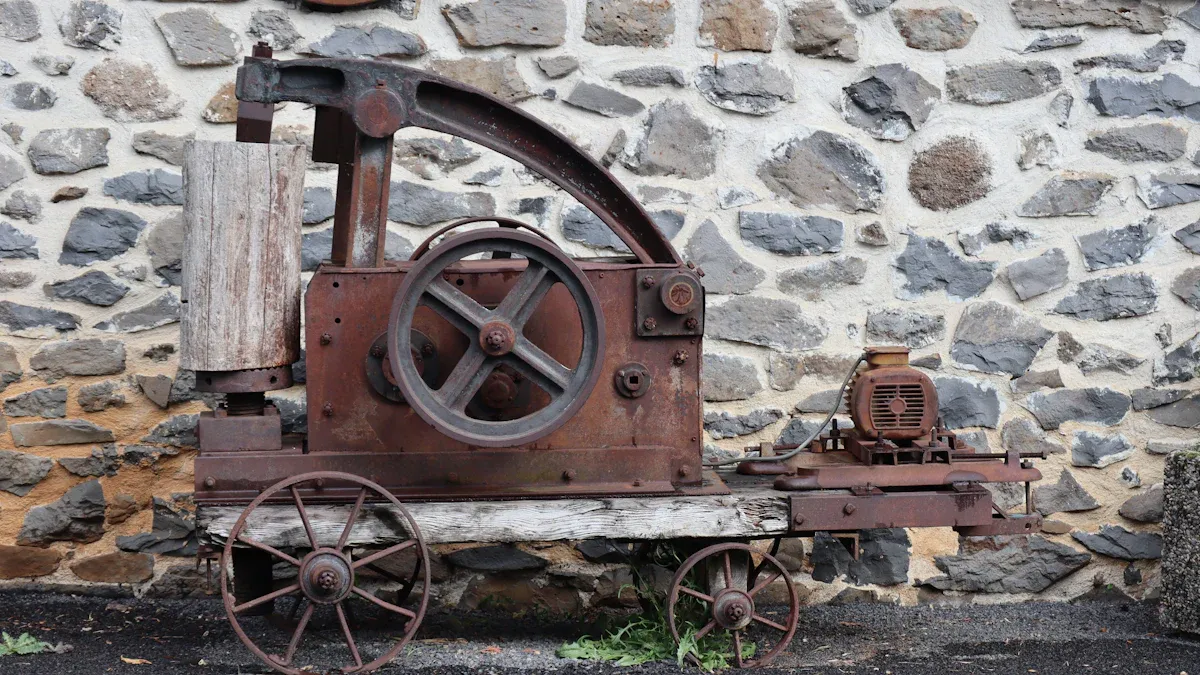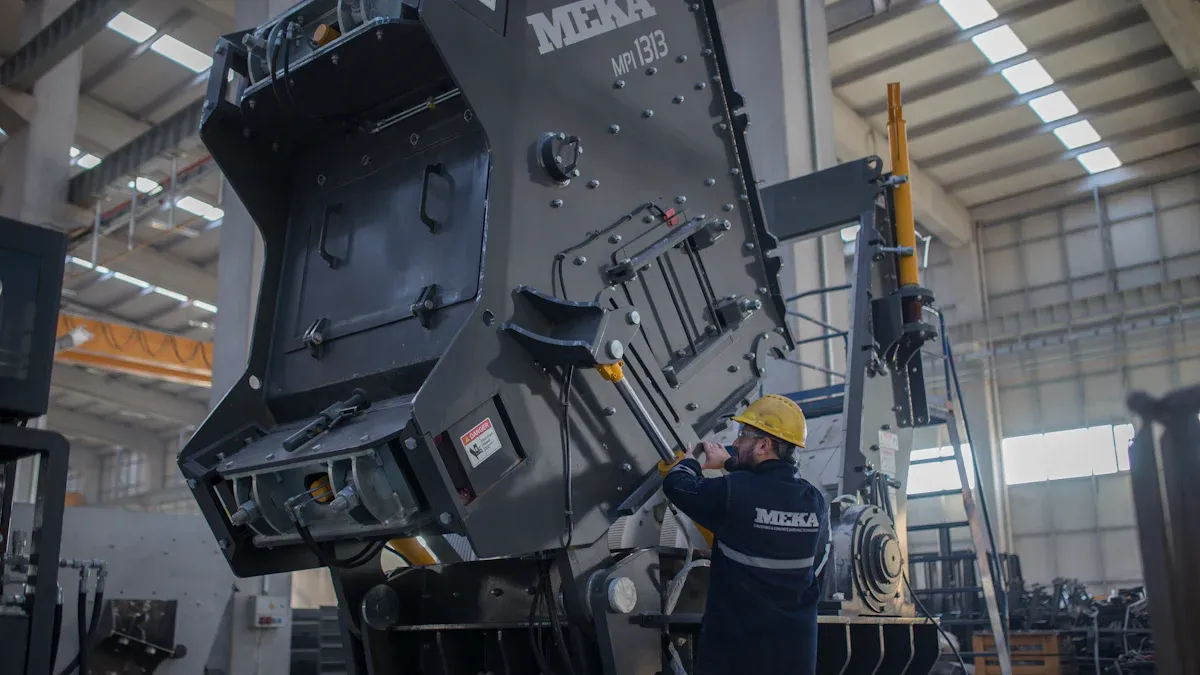
Identifying issues in the parts of jaw crusher plays a crucial role in maintaining operational efficiency. Worn components can lead to significant performance declines, resulting in increased costs and downtime. Regular inspections help operators detect problems early. This proactive approach not only enhances the lifespan of jaw crusher machine parts but also minimizes the risk of catastrophic failures. Additionally, understanding the importance of hammer crusher parts and cone crusher components can further improve overall equipment reliability. By committing to consistent maintenance and utilizing high carbon manganese steel for replacements, operators can ensure their equipment runs smoothly and efficiently.
Key Takeaways
- Regular inspections of jaw crusher parts help detect wear early, preventing costly repairs and downtime.
- Identifying signs of wear, such as cracks and uneven patterns, is crucial for maintaining optimal performance.
- Proper lubrication is essential; inadequate lubrication can lead to increased wear and potential failures.
- Addressing misalignment promptly can enhance efficiency and reduce energy consumption in jaw crushers.
- Timely repairs of cracked components prevent further damage and extend the lifespan of jaw crushers.
Worn Jaw Plates

Signs of Wear
Worn jaw plates present several visual indicators that operators can easily identify. Recognizing these signs early can prevent further damage and maintain optimal performance. Here are the most common signs of wear:
- Excessive vibration or noise
- Visible cracks or structural damage
- Thinning wear plates and liners
- Uneven wear patterns
- Reduced throughput or oversized product
- Frequent clogging or material jams
- Increased power consumption
- Bearing overheating or lubrication issues
Operators should regularly inspect jaw plates for these signs. Early detection of wear can lead to timely maintenance, which is crucial for the longevity of jaw crusher machine parts.
Impact on Performance
Worn jaw plates significantly affect the performance of a jaw crusher. As the plates wear down, they create uneven wear patterns. This inconsistency can lead to variations in the size of the output material. Consequently, operators may notice an increase in the proportion of fines or oversized particles in the crushed product.
The lifespan of jaw plates typically ranges from 1,000 to 8,000 hours, depending on the material used and operating conditions. High-quality manganese steel alloys often exceed this lifespan under optimal conditions. However, the wear resistance of the jaw plate material directly determines its service life.
In general, the service life of a jaw crusher is between 5 to 15 years. Factors such as the intensity of equipment use, maintenance systems, and working environments heavily influence this lifespan. Therefore, maintaining jaw plates in good condition is essential for ensuring efficient operation and minimizing downtime.
Poor Lubrication

Lubrication plays a vital role in the performance of jaw crushers. Poor lubrication can lead to significant problems that affect the machine’s efficiency and lifespan. Identifying lubrication issues early can prevent costly repairs and downtime.
Identifying Lubrication Issues
Operators can use several reliable methods to detect lubrication issues in jaw crusher parts. Regular monitoring and inspections are essential. Here are some effective methods:
| Method | Description |
|---|---|
| Monitoring oil pressure | Regularly check countershaft box oil pressure to establish normal levels and identify abnormalities. |
| Inspecting lube oil tank screen | Daily inspection of the return screen helps catch contaminants that could affect lubrication. |
| Oil analysis program | Implementing an oil analysis program ensures clean lube oil, which is crucial for equipment longevity. |
By employing these methods, operators can maintain optimal lubrication levels and ensure the smooth operation of jaw crusher machine parts.
Consequences of Inadequate Lubrication
Inadequate lubrication can lead to severe consequences for jaw crushers. It often results in increased wear rates due to factors such as abrasion, adhesion, fatigue, and corrosion. These factors can significantly impact the overall health and longevity of the machinery.
- High wear rates indicate poor machinery health.
- Managing wear rates directly influences machinery longevity and performance.
Lubrication failures are common in jaw crushers. According to various sources, lubrication problems rank among the most frequent failure modes in crushers. For instance, Dodge Industrial notes that inadequate lubrication often leads to failures. Shanbao Machinery and Mellott Company also emphasize the importance of timely lubricant changes to prevent machine wear and potential failure.
Effective management of wear rates is essential for maintaining machinery health. By focusing on the causes of high wear rates, operators can ensure better performance and longevity of jaw crushers. Using the right lubricants is also crucial. Recommended lubricants include greases suitable for main and pitman bearings, such as Jet-Lube Jet-Plex EP™ Grease. This lithium complex grease offers high load-carrying properties and sufficient film thickness for protection during high and shock loading.
Misalignment
Misalignment in jaw crushers can lead to various operational issues. Recognizing the symptoms of misalignment is crucial for maintaining efficiency and preventing costly repairs.
Recognizing Misalignment Symptoms
Operators should be vigilant for several signs that indicate misalignment in jaw crusher assemblies. Here are the most common symptoms:
- Excessive belt wear
- Slippage of the belts
- Noisy operation
- Visible groove damage
- Heat build-up
- Vibration issues
- Decreased crusher performance
- Pulley misalignment
Identifying these symptoms early can help operators take corrective actions before the situation worsens.
Effects on Operation
Misalignment can significantly impact the operation of jaw crushers. It often leads to increased energy consumption. For instance, a misalignment of just 0.2mm can increase energy use by 9%. This inefficiency not only raises operational costs but also affects the overall performance of the equipment.
Several factors can cause misalignment in jaw crushers. Improper installation or maintenance of the eccentric shaft may lead to bending or breaking. Ensuring correct installation and regular maintenance is essential to prevent these issues.
| Failure Reason | Solution |
|---|---|
| The toggle plate and toggle plate pad are not parallel and skewed | Check and replace the toggle plate to ensure proper alignment and tightening; Check the toggle plate pad for wear and replace if necessary. |
By addressing misalignment promptly, operators can enhance the efficiency of jaw crusher machine parts and reduce the risk of unexpected failures.
Cracked or Broken Components
Cracks or broken components in jaw crushers can lead to severe operational issues. Identifying these cracks early is essential for maintaining the efficiency of the machine. Operators should regularly inspect critical areas for signs of damage.
Identifying Cracks
Several effective non-destructive testing methods can help identify cracks in jaw crusher parts. Each method has its advantages and limitations. Here’s a summary of some common techniques:
| Method | Advantages | Limitations |
|---|---|---|
| Visual Inspection | Simple and quick to perform. | Limited to surface defects; requires good lighting and visibility. |
| Dye Penetrant Testing | Effective for detecting surface cracks; can reveal very fine defects. | Requires cleaning of the surface; not suitable for porous materials. |
| Eddy Current Testing | Good for surface-open cracks in conductive materials. | Limited penetration depth; not effective for subsurface defects. |
| Thermographic Testing | Non-contact method; can be automated; effective in production lines. | Surface must be clean; can produce false positives due to surface property changes. |
| Magnetic Particle Testing | Effective for ferromagnetic materials; can reveal surface and near-surface defects. | Subjective assessment; requires extensive cleaning; complex automation for high volumes. |
| Ultrasonic Testing | Can detect internal and surface defects; suitable for various materials. | Requires good coupling; may not detect very small surface cracks effectively. |
Using these methods, operators can detect cracks before they lead to significant failures.
Importance of Timely Repairs
Timely repairs of cracked components are crucial for the overall lifespan of jaw crushers. Addressing cracks promptly can prevent further damage and costly breakdowns. Here are some key benefits of timely repairs:
- Timely repairs and maintenance can prevent significant wear or breakdown of jaw crushers.
- Emergency repairs or rebuilding may be necessary to extend the lifespan of the equipment.
- Minimizing downtime is crucial for operational efficiency.
Implementing a proactive maintenance schedule helps operators stay ahead of potential issues. Regular inspections should focus on wear parts, looking for signs of damage or deterioration. Early detection allows for timely replacements or repairs, preventing further damage.
By prioritizing the identification and repair of cracked components, operators can enhance the reliability and performance of jaw crusher machine parts.
Excessive Vibration
Excessive vibration in jaw crushers can indicate underlying issues that may affect performance. Identifying the causes of vibration is essential for maintaining operational efficiency.
Causes of Vibration
Several factors can lead to excessive vibration in jaw crushers. Operators should be aware of the following common causes:
- Loose bottom bolts: These can lead to unstable installation, causing vibration. Regularly checking and tightening these bolts is crucial.
- Excessive swing of the moving jaw: This can create abnormal vibration. Adjusting the pads can help mitigate this issue.
- Unbalanced spindle: Prolonged overload can deform the spindle, leading to vibration. Correction or replacement may be necessary.
- Improperly installed or damaged bearings: These can also cause vibration. Checking and adjusting bearing clearance or replacing damaged bearings is essential.
By addressing these causes, operators can reduce vibration and enhance the performance of jaw crusher machine parts.
Monitoring Vibration Levels
Monitoring vibration levels is vital for predicting potential failures in jaw crushers. Vibration monitoring systems utilize IoT sensors to track real-time data such as vibration, temperature, and pressure. These systems can identify anomalies and forecast failures before they result in breakdowns.
Operators can benefit from the following features of vibration monitoring systems:
- IoT sensors monitor the health of the jaw crusher in real-time.
- AI analyzes the data to detect any anomalies, such as unusual vibrations or temperature spikes.
- The system alerts operators to potential issues before they escalate, allowing for timely maintenance.
Implementing a vibration monitoring system enables proactive maintenance, minimizing unplanned downtime and associated costs. By staying ahead of potential issues, operators can ensure the longevity and efficiency of their jaw crusher machine parts.
Jaw Crusher Machine Parts Maintenance
Maintaining jaw crusher machine parts is essential for ensuring optimal performance and longevity. Regular inspections play a crucial role in identifying potential issues before they escalate. Operators should follow a structured maintenance schedule to minimize downtime and enhance equipment reliability.
Regular Inspection Practices
Operators should conduct inspections at various intervals to catch wear early. Here are some recommended practices:
- Inspect jaw crusher parts every 250 operating hours to identify wear.
- Conduct daily, weekly, and monthly checks as part of a strict maintenance schedule.
- Perform a 1000-hour operating inspection to review the general condition and key wear components.
- Conduct an annual major inspection for a detailed assessment of all major components.
Regular inspections help operators maintain detailed records of maintenance activities. Following manufacturer guidelines ensures timely replacement of wear parts and prompt addressing of defects. Daily maintenance can prevent 20-30% of unplanned downtime and helps identify issues before they lead to costly repairs. A systematic approach to preventive maintenance maximizes equipment life while minimizing unexpected downtime.
Importance of Lubrication
Proper lubrication is vital for the efficient operation of jaw crushers. Insufficient lubrication can lead to severe wear and even shaft fractures due to increased friction. Operators should use the right lubricants to prevent premature wear. Here are some best practices for lubrication:
| Lubricant Type | Characteristics and Advantages | Recommended Applications in Jaw Crushers |
|---|---|---|
| Oils | Flow easily, cool and remove contaminants, need regular maintenance | Bearings, gears, eccentric shafts |
| Greases | Stay in place, seal and protect, reduce noise and vibration | Bushings, pins, chains, slides |
Operators should apply grease to bushings and toggle plates every 3-4 hours. They must also ensure oil return temperature stays below 60°C and regularly check lubricant levels and quality. Automated lubrication systems can provide a steady supply of lubricant to critical components. This consistency reduces wear and prolongs equipment lifespan, leading to lower maintenance costs and increased operational efficiency.
Identifying common issues in jaw crusher parts is vital for maintaining efficiency and productivity. Regular maintenance and inspections offer numerous benefits:
| Benefit | Description |
|---|---|
| Efficiency | Regular maintenance leads to improved operational efficiency, akin to compounding interest. |
| Productivity | Consistent maintenance routines enhance overall productivity and operational smoothness. |
| Safety | Regular inspections mitigate hazards, ensuring the safety of both operators and equipment. |
| Cost Savings | Long-term maintenance efforts contribute to lower operating costs and better reliability. |
| Competitive Advantage | Companies that prioritize maintenance build reputations for reliability and operational excellence. |
Operators should take proactive measures to ensure optimal performance. Effective management of wear parts helps control costs and maintain performance. By implementing a planned replacement program and monitoring wear patterns, they can minimize unexpected failures and reduce repair expenses. Prioritizing maintenance not only enhances equipment longevity but also boosts overall productivity.
FAQ
What are the common signs of wear in jaw crusher parts?
Operators should look for excessive vibration, visible cracks, uneven wear patterns, and reduced throughput. Regular inspections help identify these signs early, preventing further damage.
How often should jaw crusher parts be inspected?
Operators should inspect jaw crusher parts every 250 operating hours. Daily, weekly, and monthly checks are also essential to maintain optimal performance and prevent unexpected failures.
What are the consequences of poor lubrication in jaw crushers?
Inadequate lubrication leads to increased wear rates, overheating, and potential component failure. Regular lubrication checks and timely oil changes are crucial for maintaining equipment health.
How can misalignment affect jaw crusher performance?
Misalignment can increase energy consumption and lead to excessive wear on components. Operators should regularly check for signs of misalignment to ensure efficient operation.
Why is timely repair of cracked components important?
Timely repairs prevent further damage and costly breakdowns. Addressing cracks early enhances the reliability and performance of jaw crushers, extending their lifespan and reducing downtime.
Post time: Oct-22-2025